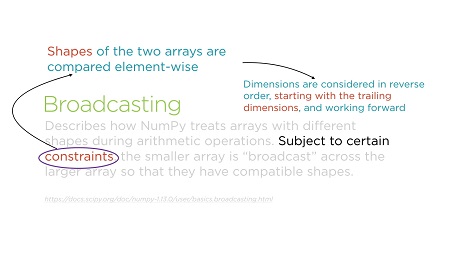
English | MP4 | AVC 1280×720 | AAC 44KHz 2ch | 1h 43m | 209 MB
As working with huge numeric datasets becomes the norm, using the right tools and libraries to work with the data becomes very important. NumPy allows data analysts and data scientists to work with multi-dimensional data to solve these problems.
As machine learning and deep learning techniques become popular, getting the dataset into the right numeric form and engineering the right features to feed into ML models becomes critical. In this course, Working with Multidimensional Data Using NumPy, you’ll learn the simple and intuitive functions and classes that NumPy offers to work with data of high dimensionality. First, you will get familiar with basic operations to explore multi-dimensional data, such as creating, printing, and performing basic mathematical operations with arrays. You’ll study indexing and slicing of array data and iterating over lists and see how images are basically 3D arrays and how they can be manipulated with NumPy. Next, you will move on to complex indexing functions. NumPy arrays can be indexed with conditional functions as well as arrays of indices. You’ll then see how broadcasting rules work which allows NumPy to perform operations on arrays with different shapes as well as, study array operations such as np.argmax() which are very common when working with ML problems. Finally, you’ll study how NumPy integrates with other libraries in the PyData stack. You will also cover specific implementations with SciPy and with Pandas. At the end of this course, you will be comfortable using the array manipulation techniques that NumPy has to offer to get your data in the right form for extracting insights.
Table of Contents
Course Overview
1 Course Overview
Exploring Multidimensional Data Using NumPy
2 Module Overview
3 Prerequisites and Course Overview
4 Creating Arrays
5 Printing Arrays
6 Basic Array Operations
7 Universal Functions
8 Indexing and Slicing Arrays
9 Iterating Over Arrays
10 Reshaping Arrays
11 Splitting Arrays Horizontally and Vertically
12 Image Manipulation
13 Shallow Copies Using View
14 Deep Copies Using Copy
Complex Indexing Using NumPy
15 Module Overview
16 Indexing Arrays Using Arrays
17 Fancy Indexing with GDP Data
18 Indexing with Boolean Arrays
19 Arrays with Structured Data
20 Broadcasting
21 Broadcasting Scalars and Arrays
22 Automatic Reshaping
23 Stacking Arrays
24 Histograms
25 Miscellaneous Operations
Leveraging Other Python Libraries with NumPy
26 Module Overview
27 Working with Pandas
28 Working with SciPy
29 Vectorization
30 Summary and Further Study
Resolve the captcha to access the links!